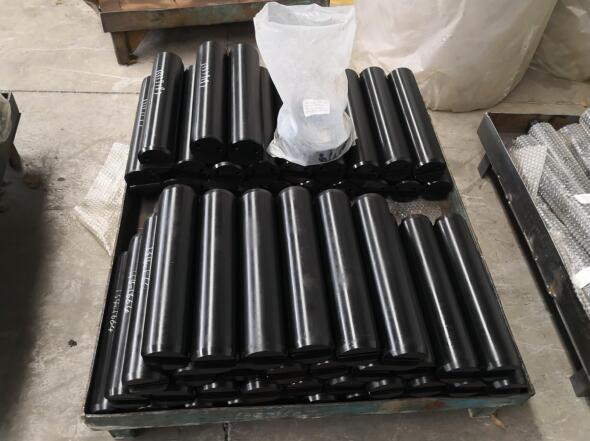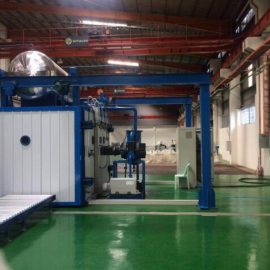QPQ Salt Bath Liquid Nitriding Surface Technology Inspection Procedure
1. Visual inspection
The surface of the workpiece treated by QPQ should be black or blue-black. The appearance of a commodity workpiece should be inspected according to relevant product standards and process documents. For example, a commercial metal cutting tool requires an appearance inspection after surface treatment: Under 500LX illuminance, the surface color should be relatively uniform and consistent with the naked eye at a distance of 300mm from the lamp, and there should be no obvious spots, rust, and redness. The appearance of the work piece should not be checked outdoors under strong sunlight.
When there are no strict appearance requirements for general mechanical parts, the appearance inspection may not be performed.
2. Corrosion resistance inspection
After the workpiece is processed by QPQ, you can use a simple method to check whether the infiltration layer is complete or whether the workpiece has a certain anti-rust ability. Use a 10% CuSO4 aqueous solution to drop on the non-edge corners of the workpiece. For the tool, no copper will be precipitated within 10 minutes. For general mechanical parts, if no copper is precipitated within 30 minutes, it means that there is a complete layer of penetration and a certain degree of anti-rust ability.
When there are no special requirements for general mechanical parts, no corrosion resistance inspection is performed.

3. Quality inspection of seepage layer
The quality inspection of the seepage layer should use the same material as the workpiece and the same original state sample. However, under mass production conditions, when there are many varieties of materials, the quality of the infiltration layer of 45 steel is often used to check the state of the salt bath, which initially reflects the infiltration situation of the workpiece.
3.1 Infiltration layer hardness inspection
3.1.1 Inspection of surface hardness of infiltrated layer
The surface hardness of the infiltrated layer is usually tested with a load of 100g for microhardness testing, and it can also be measured with a low-load Vickers hardness. It cannot be measured with a large load hardness tester such as Rockwell, and the hardness cannot be checked with a file. For measuring the hardness of the sample, use 04# or 05# sandpaper to prepare the sample before QPQ treatment. After treatment, use the same sandpaper to lightly polish until a smooth and clean metal surface is seen, and then measure on the polished surface. hardness. The weight of the sandpaper has a greater impact on the hardness measurement results. If the sandpaper is ground too lightly, the loose layer on the surface of the permeated layer is not worn off, and the hardness will be low, sometimes much lower; if it is ground too heavily, the permeated layer will be too thin, and the hardness value will be low. Therefore, when testing the hardness in the initial stage or for novices, the paper should be sanded repeatedly from light to heavy, and the highest hardness value measured shall prevail.
3.1.2 Hardness inspection of seepage layer section
When necessary, the hardness gradient of the seepage layer section can be checked. During the section hardness inspection, the surface of the seepage layer should be ground with a grinding wheel about 1mm to ensure that the seepage layer is completely removed and the core is exposed. Then polish and prepare the samples according to the metallographic sample preparation requirements. During the measurement, the microhardness value was measured at intervals of 0.01mm from the surface inward with a load of 50g. Finally, draw a hardness gradient curve based on the hardness data.
3.1.3 Hardness requirements of the workpiece
In principle, the hardness requirements of the workpiece are determined according to the type of material.
Carbon steel, low alloy steel: HV500-700
Hot die steel, casting die steel, die steel: HV700-900
All kinds of stainless steel: HV900—1100
All kinds of high-speed steel: HV950-1200
The user should formulate the hardness requirement standard of the permeable layer of the product according to the specific situation of the product of the factory, and include it in the process document. Under normal circumstances, the microhardness is checked once a week.
3.2 In-depth inspection of seepage layer
The inspection of the depth of the permeation layer usually checks the depth of the compound layer, while the depth of the oxide film is generally not inspected. The depth of the diffusion layer is only inspected when required.
When checking the depth of the seepage layer, in order to ensure that the seepage layer does not fall off or beveled during the sample preparation process, the sample should be clamped in a special fixture. There should be no gap between the sample and the stainless steel sheet.
For general tool steel and structural steel, the corrosive agent for the depth inspection of the penetration layer can be 3-5% nitric acid alcohol solution.
For the inspection of the infiltration layer of stainless steel and heat-resistant steel, when the effect of common corrosives is not good, ferric chloride solution can be used:
CuCL2, 2NH4, H2O: 0.5g
FeCL3: 6g
HCL: 2.5ml
H2O: 75ML
Selenic acid or selenous acid etchant can be used for iron castings:
H2SeO4: 3ml (or H2SeO3 5g)
HCL: 20ml (10ml: for H2SeO3)
C2H5OH: 100ml
The inspection of the diffusion layer is generally more convenient by using the metallographic method. After the sample is corroded, the end of the needle-shaped nitride is measured as the depth of the diffusion layer (Degussa, Germany uses twice the depth of the needle-shaped structure as the depth of the diffusion layer). The acicular structure is not obvious after the carbon steel is treated. It can be tempered at 300°C for 2 hours to make the boundary between the infiltrated layer and the center more obvious. It is usually observed at a magnification of 500 times.
The section hardness method is used to measure the microhardness (100g) from the centripetal part of the surface of the sample.
The effective hardened layer depth (including compound layer) is measured from the surface to the point where the microhardness is 30-50 Hv higher than the center. The hardness method may be more accurate.
In terms of penetration layer depth, high-speed steel tools require a diffusion layer depth of generally 20~30μ, and no compound layer is allowed, otherwise the tool will easily chip during cutting.
For general structural steel parts, the compound layer should be 10~25μ, and the diffusion layer should be 0.3~0.5mm. The specific permeability index of each product should be formulated in accordance with the requirements of relevant standards or product drawings and included in the process documents.
3.3 Density inspection of seepage layer
The compound layer often has different degrees of looseness, which causes the compound layer to be not dense and affects its wear resistance. According to the severity of porosity, it can be divided into 5 levels, 1 to 3 are qualified, 4 and 5 are unqualified.
3.4 Inspection of brittleness of permeable layer
The brittleness check of the seepage layer is in accordance with GB11354-89, using a Vickers indenter with a load of 10kg, load slowly, stay for 5-10 seconds after loading, and then remove the load. The indentation is inspected at 100 times magnification. Three points are measured for each test piece. When at least two points are at the same level, the brittleness level can be determined. According to the national standard requirements 1~3 are qualified.

40Cr Steel Quenching And Tempering Treatment Process Spider Annealing Furnace Preparation Work Before Gas Nitriding Of Workpiece


Contact us
Your email address will not be published. Required fields are marked *